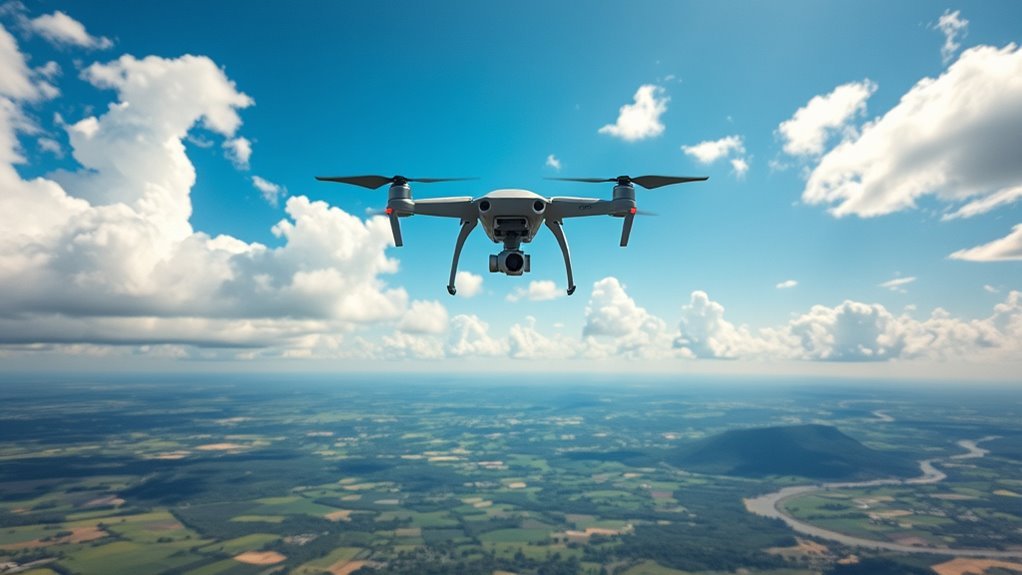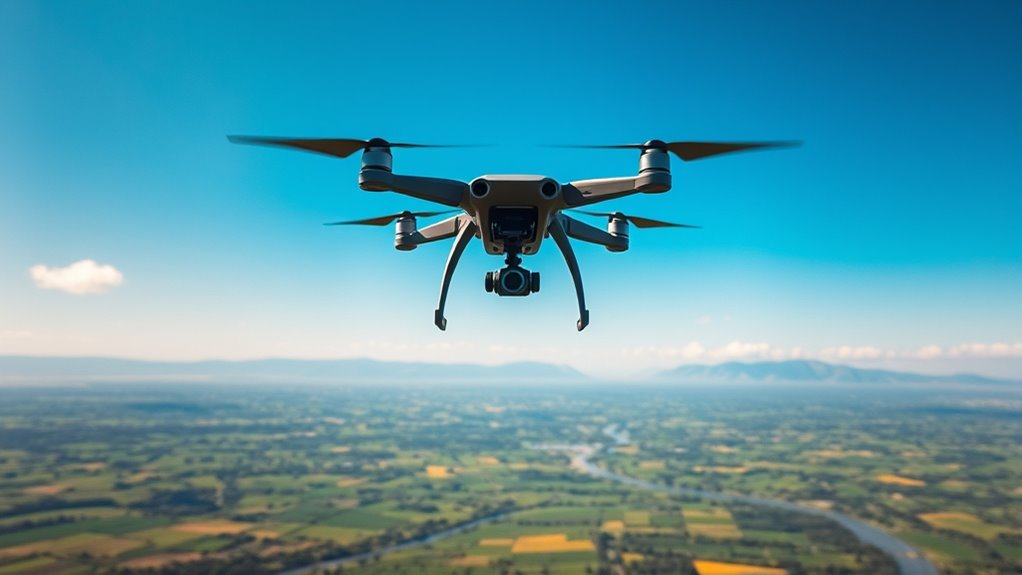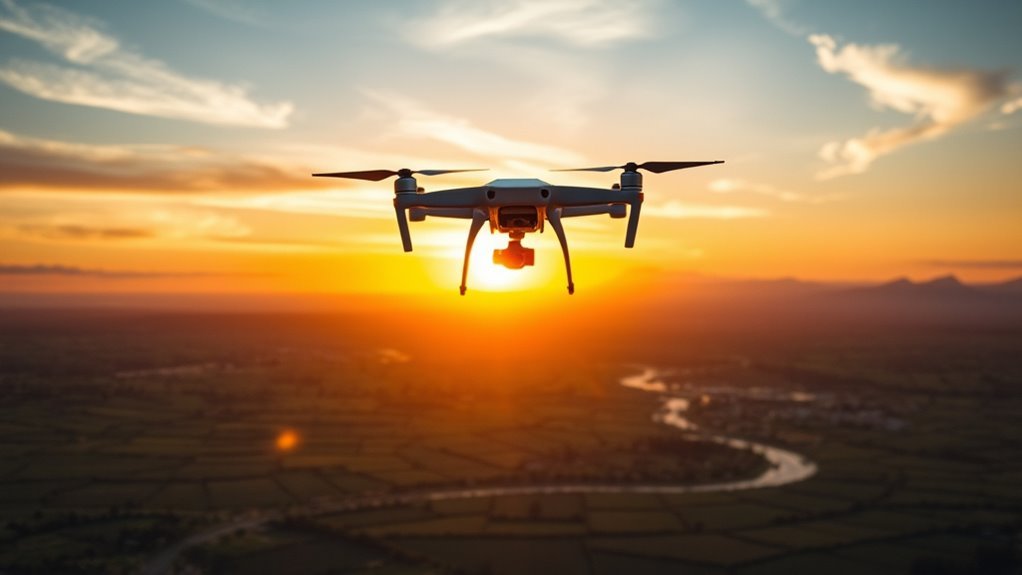Legally, you can fly a drone up to 400 feet above ground level (AGL) for recreational purposes, according to FAA regulations. If you’re operating commercially, the altitude can still be 400 feet AGL in Class G airspace, but permissions are required in Classes B and C. Flying near airports involves stricter rules. Ignoring altitude limits can lead to serious consequences. Understanding these regulations is essential for safe operations and to avoid legal issues, so let’s explore more.
Understanding FAA Regulations on Drone Altitude

When you’re flying a drone, it’s essential to understand the regulations set by the Federal Aviation Administration (FAA) regarding altitude limits. These rules aren’t just bureaucratic red tape; they’re vital for drone safety and maintaining a balanced airspace. By being aware of altitude restrictions, you can minimize risks to manned aircraft and avoid potential legal issues. The FAA emphasizes the importance of altitude awareness to guarantee that your flying experience remains enjoyable and compliant. Familiarize yourself with local laws, as they may add specific limitations. By respecting these regulations, you’re not only flying responsibly but also contributing to a safer environment for everyone in the sky. So, keep your drone within the legal altitude limits and embrace the freedom of flight!
Maximum Altitude Limits for Recreational Drones

Although flying a drone can be exhilarating, it’s vital to know the maximum altitude limits set for recreational use. For hobbyists in the U.S., the Federal Aviation Administration (FAA) enforces a maximum height of 400 feet above ground level. Staying within this limit not only guarantees compliance with regulations but also enhances drone safety. Flying higher increases the risk of collisions with manned aircraft, which can lead to serious consequences. Remember, while you may crave the freedom of soaring high, adhering to these altitude restrictions is essential. By respecting the maximum height, you contribute to a safer airspace for everyone. So, keep your drone under 400 feet and enjoy your flying experience responsibly.
Commercial Drone Flight Altitudes and Requirements

Understanding the altitude limits and requirements for commercial drone flights is essential for operators aiming to utilize these devices for business purposes. You’ll need to be aware of the designated drone flight zones and comply with altitude monitoring regulations to guarantee safe operations.
| Zone Type | Maximum Altitude | Requirements |
|---|---|---|
| Class G Airspace | 400 ft AGL | No special permissions |
| Class B Airspace | 400 ft AGL | ATC permission required |
| Class C Airspace | 400 ft AGL | ATC permission required |
| Restricted Zones | Varies | Must comply with restrictions |
Special Considerations for Flying Near Airports
Flying near airports presents unique challenges and regulations that drone operators must navigate carefully. When you’re in close airport proximity, understanding airspace classification becomes essential. Most airports are surrounded by controlled airspace, which restricts drone flights to guarantee safety for manned aircraft. You’ll need to check the specific classifications—Class B, C, D, or E—to determine your altitude limits and operational permissions. Additionally, you may need to request authorization before flying, especially in more restrictive zones. Always be aware of nearby flight paths and communicate with air traffic control if necessary. Federal Aviation Regulations establish the legal framework that governs these operations. By respecting these regulations, you not only guarantee safety but also preserve your freedom to operate your drone without complications. Moreover, unauthorized drone flights in these areas can lead to significant legal consequences, including fines and possible suspension of operations. Stay informed and fly smart!
Consequences of Violating Altitude Restrictions
Operating a drone near airports can heighten the risks associated with altitude restrictions. Violating these limits isn’t just a minor oversight; it can lead to significant legal penalties. You could face hefty fines or even criminal charges, depending on the severity of the breach. Additionally, ignoring altitude rules jeopardizes safety, not only for yourself but also for others. Drones flying too high can interfere with manned aircraft, increasing the potential for accidents. The controller frequency bands you operate on can also impact your drone’s ability to maintain safe communication with the ground. The freedom you seek in flying comes with responsibility, and noncompliance can quickly strip that freedom away. To enjoy your drone experience without repercussions, always adhere to altitude restrictions and be mindful of your surroundings. Moreover, compliance with regulations is crucial to prevent interference with manned aircraft and ensure safe operations. The thrill of flight shouldn’t come at the cost of safety or legality.
Frequently Asked Questions
Can I Fly a Drone Higher Than 400 Feet in Certain Circumstances?
You can fly a drone higher than 400 feet under specific conditions, but you’ll need to comply with drone altitude regulations and prioritize aviation safety considerations to guarantee responsible and lawful operation.
Are There Altitude Restrictions for Drone Racing Events?
In drone racing, altitude regulations can vary by event. Generally, there’re limits to guarantee safety and fairness. It’s essential to check specific race guidelines to understand the allowed altitudes for peak performance and compliance.
Do Altitude Limits Differ by State or Locality?
Altitude limits can vary considerably based on local regulations and state variations. You should always check your area’s specific rules to guarantee compliance, allowing you to enjoy your drone flying experience without legal complications.
Can I Fly a Drone Above 400 Feet if I Have a Waiver?
Yes, you can fly above 400 feet if you’ve obtained a waiver, as long as you meet the waiver requirements. Always check the specific altitude regulations in your area to guarantee compliance.
Are There Any Altitude Exceptions for Emergency Drone Operations?
In emergency situations, think of your drone as a lifeline. While drone regulations typically limit altitude, exceptions may exist for urgent operations, allowing you to soar higher when lives depend on it. Always check local laws.

